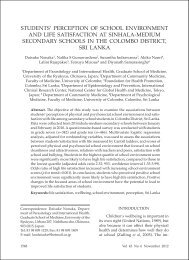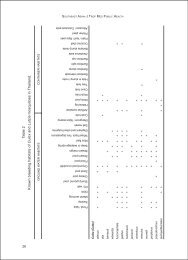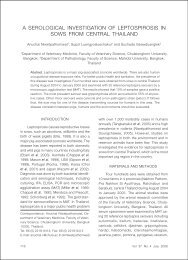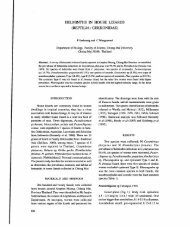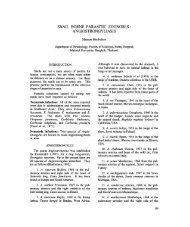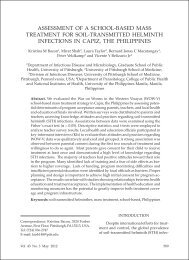bacterial meningitis incidence in thai children estimated by a rapid ...
bacterial meningitis incidence in thai children estimated by a rapid ...
bacterial meningitis incidence in thai children estimated by a rapid ...
Create successful ePaper yourself
Turn your PDF publications into a flip-book with our unique Google optimized e-Paper software.
(13.3%) (p=0.002). These proportions can be<br />
applied for the whole year and <strong>in</strong> different<br />
age groups, s<strong>in</strong>ce there was neither seasonality<br />
nor age relationship to CSF f<strong>in</strong>d<strong>in</strong>gs.<br />
However, there were some differences <strong>by</strong><br />
region (Table 2). These differences may reflect<br />
variability <strong>in</strong> laboratory quality and/or<br />
disease etiologies.<br />
The validity of the adjustment depends<br />
on the capability of the laboratories which<br />
varied from facility to facility, but the adjusted<br />
factors us<strong>in</strong>g the RAT applied equally<br />
to all laboratories. Some laboratories <strong>in</strong> the<br />
studied areas not only performed CSF cultures<br />
and Gram’s sta<strong>in</strong>s, but also carried out<br />
other <strong>in</strong>vestigations, such as hemoculture,<br />
latex agglut<strong>in</strong>ation test (LA), and CIE. These<br />
<strong>in</strong>vestigations were performed <strong>in</strong> prov<strong>in</strong>cial<br />
hospitals <strong>in</strong> 4 prov<strong>in</strong>ces but not <strong>in</strong> the northeast.<br />
These hospitals covered 70.7% of all the<br />
suspected <strong>men<strong>in</strong>gitis</strong> cases enrolled <strong>in</strong> this<br />
study. These <strong>in</strong>vestigations <strong>in</strong>crease the sensitivity<br />
for detect<strong>in</strong>g the causative bacteria<br />
among suspected <strong>men<strong>in</strong>gitis</strong> cases (Gray<br />
and Fedorko, 1992). Therefore, the unconfirmed<br />
<strong>bacterial</strong> <strong>men<strong>in</strong>gitis</strong> cases <strong>in</strong> these<br />
prov<strong>in</strong>cial hospitals would have a lower<br />
chance of be<strong>in</strong>g <strong>bacterial</strong> <strong>men<strong>in</strong>gitis</strong> with the<br />
adjust<strong>in</strong>g factor applied. Therefore, the adjustment<br />
would give an over estimation of<br />
the number of cases.<br />
Due to the above reasons the <strong>estimated</strong><br />
<strong><strong>in</strong>cidence</strong> of <strong>men<strong>in</strong>gitis</strong> should be somewhere<br />
between the unadjusted <strong><strong>in</strong>cidence</strong>, as<br />
a low estimate, and the adjusted <strong><strong>in</strong>cidence</strong>,<br />
as a high estimate. Therefore, the Hib <strong><strong>in</strong>cidence</strong><br />
should fall between 3.0 and 6.1/<br />
100,000, which are unadjusted and adjusted<br />
<strong><strong>in</strong>cidence</strong>s, respectively. This is <strong>in</strong> l<strong>in</strong>e with<br />
the estimate from a prospective population<br />
based study done <strong>in</strong> Thailand <strong>in</strong> 2000 (3.8/<br />
100,000) (Rerks-Ngarm et al, 2004). The Hib<br />
<strong><strong>in</strong>cidence</strong> is also <strong>in</strong> l<strong>in</strong>e with low rates of Hib<br />
<strong>men<strong>in</strong>gitis</strong> found <strong>in</strong> retrospective and prospective<br />
studies from other parts of Asia<br />
SOUTHEAST ASIAN J TROP MED PUBLIC HEALTH<br />
(Lau et al, 1995; Sung et al, 1997; Kamiya et<br />
al, 1998; Yang et al, 1998; Lee et al, 2000;<br />
Kilgore et al, 2002).<br />
Regard<strong>in</strong>g the etiologies and age distributions<br />
for <strong>men<strong>in</strong>gitis</strong> cases, the f<strong>in</strong>d<strong>in</strong>gs<br />
from this study are compatible with a<br />
study from Children’s Hospital, Bangkok,<br />
where Hib was the ma<strong>in</strong> causative agent<br />
for <strong>bacterial</strong> <strong>men<strong>in</strong>gitis</strong> among young <strong>children</strong>,<br />
especially those under one year of age<br />
(Chotpitayasunondh, 1998). S. pneumoniae<br />
is the second most common <strong>bacterial</strong><br />
cause of <strong>men<strong>in</strong>gitis</strong> <strong>in</strong> Thai <strong>children</strong>, while<br />
it is the most common etiology of community<br />
acquired <strong>bacterial</strong> <strong>men<strong>in</strong>gitis</strong> <strong>in</strong> Thai<br />
adults compris<strong>in</strong>g 11.7-28% of all causes<br />
(Chotmongkol et al, 2000; Khwannimit et al,<br />
2004). Of the 6 cases of gram-positive cocci<br />
m<strong>in</strong><strong>in</strong>gitis <strong>in</strong> our study, 3 had gram-positive<br />
diplococci, which were most likely S.<br />
pneumoniae m<strong>in</strong><strong>in</strong>gitis cases. Therefore, the<br />
<strong><strong>in</strong>cidence</strong> of pneumococcal <strong>men<strong>in</strong>gitis</strong> cases<br />
<strong>in</strong> Thai <strong>children</strong> should be about 1.0-2.2/<br />
100,000. The <strong>estimated</strong> <strong><strong>in</strong>cidence</strong> of pneumococcal<br />
<strong>men<strong>in</strong>gitis</strong> <strong>in</strong> this study is also <strong>in</strong><br />
l<strong>in</strong>e with that found <strong>in</strong> a prospective study<br />
(Rerks-Ngarm et al, 2004).<br />
The overall case-fatality rate <strong>in</strong> this<br />
study was much lower than that found <strong>in</strong><br />
the Children’s Hospital, at 5.3% vs 12.9-<br />
25.6%, respectively (Chotpitayasunondh,<br />
1998). This difference probably reflects improvement<br />
<strong>in</strong> treatment . There was no seasonality<br />
<strong>in</strong> confirmed <strong>bacterial</strong> <strong>men<strong>in</strong>gitis</strong><br />
cases similar to a report from the national<br />
surveillance system (Division of Epidemiology,<br />
1998). However, unconfirmed <strong>bacterial</strong><br />
<strong>men<strong>in</strong>gitis</strong> cases tended to occur more often<br />
(12 cases) dur<strong>in</strong>g the second six months of<br />
the year. On further analysis no significant<br />
relationships or clusters of cases happened.<br />
In conclusion, Hib, gram-positive cocci,<br />
gram-negative bacilli and N. men<strong>in</strong>gitidis<br />
were the most common causes of <strong>bacterial</strong><br />
<strong>men<strong>in</strong>gitis</strong> among Thai <strong>children</strong> <strong>in</strong> this<br />
560 Vol 40 No. 3 May 2009



